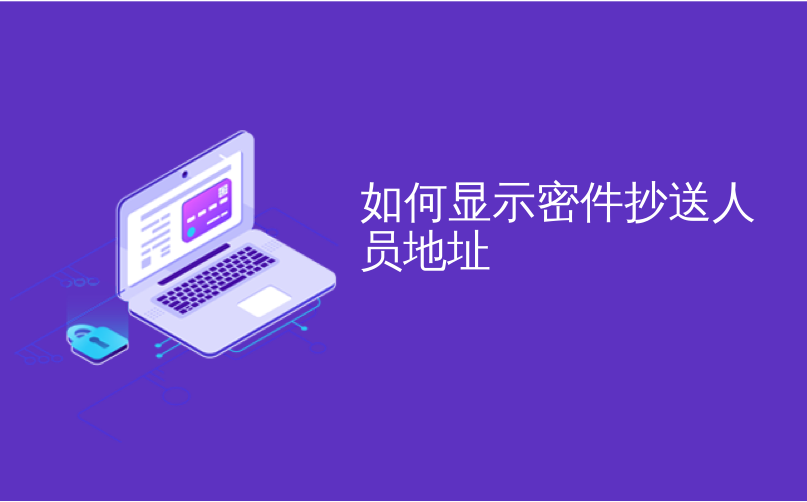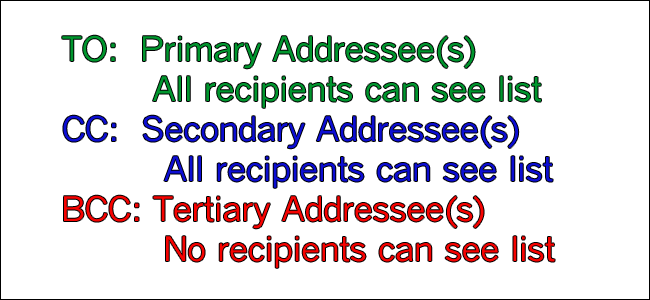
如何显示密件抄送人员地址

Few amenities in the modern digital workflow are so widely available but so widely ignored (or outright abused) as the the email BCC function. If you’re guilty of misusing or neglecting its power (and there’s a good chance you are), it’s time to repent and, in the process, cut down on spam and protect the privacy of your friends and family.
在现代数字工作流程中,很少有设施像电子邮件密件抄送功能那样被广泛使用,但是却被广泛忽略(或完全滥用)。 如果您因滥用或忽视其功能而感到内((很可能是您),该是pent悔的时候了,在此过程中,您应减少垃圾邮件并保护您的朋友和家人的隐私。
什么是密件抄送,它是从哪里来的? (What Is BCC and Where Did It Come From?)
In mid-century business memos, for example, there would be a TO slot for the primary recipient, a CC slot for individuals who needed to be in on the communication but who were not the primary recipients, and a third slot, BCC, for individuals who needed to be in on the communication too but, for whatever reason, their identity would be withheld from the memos circulated to the recipients in the TO and CC address slots.
例如,在本世纪中叶的业务备忘录中,主要收件人有一个TO插槽,需要交流的个人有一个CC插槽,但不是主要收件人,个人有一个CC插槽,个人也需要参与交流,但是无论出于何种原因,他们的身份都将从发送给收件人和抄送地址插槽中的收件人的备忘录中保留。

Upon the advent of electronic mail, the same conventions used in paper mail and memos were copied, both out of familiarity and because they remained useful even though the message was no longer physically copied and delivered.
随着电子邮件的出现,出于熟悉的目的并且因为即使不再物理地复制和传递邮件,它们仍然有用,因此复制了纸质邮件和备忘录中使用的相同约定。
If these conventions existed for decades before the advent of email and have continued to exist in the intervening half century or so, where then does the trouble arise? There are two forms of BCC misuse: passive-aggressive blind carbon copying (the malicious form form of trouble) and neglect to use blind-carbon copying to protect privacy (trouble which arises from ignorance). Let’s take a look at how and why to avoid each.
如果这些约定在电子邮件出现之前已经存在了数十年,并且在中间的半个世纪中一直存在,那么麻烦会在哪里出现? BCC滥用有两种形式:被动侵略性盲目抄写(恶意形式的麻烦)和疏忽大意使用盲目抄写保护隐私(由于无知而引起的麻烦)。 让我们看一下如何以及为什么避免它们。
对被动攻击性盲抄碳说不 (Say No to Passive-Aggressive Blind Carbon Copying)

The worst use of the blind carbon copy is to passively aggressively ensnare a coworker. This kind of BCC abuse crops up when employees resort to using the BCC function as a way of indirectly tattling on their coworkers, sucking up to their boss, or otherwise engaging in dysfunctional workplace hijinks.
盲目抄写的最坏用途是被动地主动招募同事。 当员工诉诸于使用BCC功能作为间接诱骗同事,吸吮老板或以其他方式从事工作不正常的工作时,这种BCC滥用现象就会浮出水面。
Image courtesy of EC Comics.
图片由EC Comics提供。
An employee, for example, might put their boss as the BCC addressee on an email they are sending to another employee so that their boss sees that they are communicating with the other employee or that the other employee is failing to meet some sort of obligation or deadline. This kind of secret-squirrel communication is generally frowned upon in the workplace and we’re not about to endorse any sort of behavior that breeds a petty and passive aggressive work environment.
例如,某个员工可能会在发送给另一位员工的电子邮件中将其老板作为密件抄送收件人,以便其老板看到他们正在与另一位员工进行通信,或者另一位员工未能履行某种义务,或者最后期限。 这种秘密松鼠的交流在工作场所中通常是不受欢迎的,我们不会认可任何会滋生琐碎而被动的积极工作环境的行为。
Our only advice on the matter is: Stop it.
我们对此的唯一建议是:停止它。
Unless your HR department or your boss explicitly comes to you and instructs you to BCC your communications, you should avoid the practice.
除非您的人事部门或老板明确地找您并指示您进行密件抄送,否则您应该避免这种做法。
If people outside the primary communication need to be kept in the loop, even higher ups, the best practice is to include them as CC addressees and to notify the TO addressees as to who was included and for what reason.
如果主要通信之外的人员需要保持联系,甚至更高的级别,最好的做法是将他们包括为抄送收件人,并通知TO收件人有关谁被包括在内以及出于什么原因。
Not only does this build a more mature dialog in the workplace, it also helps you avoid a particularly embarrassing event: if your boss or other BCC recipient uses the reply-all function they effectively unmask themselves and reveal that they have been privy to the content of the prior email. Try explaining that one to the coworker you were conspiring against at the water cooler.
这不仅可以在工作场所建立更成熟的对话,还可以帮助您避免发生一个特别令人尴尬的事件:如果老板或其他BCC收件人使用“全部答复”功能,他们将有效地掩盖自己并显示出他们对内容的保密性之前的电子邮件。 尝试向您在水冷却器上阴谋的同事解释一个。
Fortunately, the number of people maliciously using the BCC function is small, which leads us to those who make up the bulk of the abuse: the unwitting.
幸运的是,恶意使用BCC功能的人数很少,这导致我们构成了大部分滥用行为的人:无意识的人。
朋友不要抄袭朋友 (Friends Don’t Carbon Copy Friends)

If the majority of people aren’t maliciously using the BCC function as part of a psychological warfare campaign against their coworkers, then where does that leave us? It leaves us with the millions of people who unwittingly neglect to even use the BCC function in the first place.
如果大多数人不是在针对同事的心理战中恶意使用BCC功能,那这又会给我们带来什么呢? 它使我们离开了数以百万计的人,他们一开始就无意间忽略了BCC功能。
Image courtesy of the Denver Public Library, Western History Collection.
图片由丹佛公共图书馆提供,西方历史收藏。
Why is the BCC function so important? It allows you to send an email to someone without that person seeing everyone else that receives the email, effectively safeguarding their private information. Here is an example email forward, culled from our own email archives:
为什么BCC功能如此重要? 它使您可以向某人发送电子邮件,而该人不会看到收到该电子邮件的其他所有人,从而有效地保护了他们的私人信息。 以下是从我们自己的电子邮件存档中挑选出来的电子邮件转发示例:

Every blue blur in the privacy-filtered image above is an email address. Not only were there over 40 email addresses in the list of forward recipients we were included in on, but there are two sets of leftover forward blocks in the forwarded email (seen above) that include 13 and 8 email addresses, respectively. This means that there are over 60 email addresses in the complete body of the email.
上面经过隐私过滤的图像中的每个蓝色模糊都是一个电子邮件地址。 我们包括在其中的转发收件人列表中不仅有40多个电子邮件地址,而且在转发的电子邮件(如上所示)中有两组剩余的转发块,分别包含13和8个电子邮件地址。 这意味着电子邮件的整个正文中有60多个电子邮件地址。
Now, you may be asking yourself “So what? What does it matter?” It matters for several reasons. First and foremost, there is the simple issue of privacy and treating the privacy of the people on your contact list (be they friends, family, or business associates) respectfully. It goes without saying that the people who fire off forwards and mass emails with dozens of their friends and associates do not take the time to personally contact each of those dozens of recipients and ask if they would like their contact information shared with everyone else on the addressee list. It’s outright disrespectful to share contact information without the permission of the individual in question.
现在,您可能会问自己:“那又如何? 有什么关系?” 这很重要,原因有几个。 首先,最重要的是隐私问题,要尊重您联系人列表中的人(无论是朋友,家人还是业务伙伴)的隐私。 不用说,与数十个朋友和同事进行转发和批量发送电子邮件的人不会花时间亲自与数十个收件人中的每一个联系,并询问他们是否希望与网上的其他所有人共享联系信息。收件人列表。 未经相关个人许可而共享联系信息是完全不尊重的。
Worse yet, if anyone accidentally hits “Reply All” to any of the emails you send out with fully loaded TO and CC slots, every single person on the original recipient list receives the reply. At best, that’s relatively harmless but certainly wastes the time of everyone else as they open the email to see what’s new in the discussion. At worst, as has happened many times in corporations across the world, the email can take on a life of its own as hundreds of employees reply, argue, and otherwise interact with the email. Such a reply-all chain reactions can span thousands of emails and can even spawn flame wars (there was one such flame war at Tandem Computers in the late 20th century that lasted for years).
更糟糕的是,如果有人不小心在您发送的满载TO和CC插槽的电子邮件中打了“全部答复”, 则原始收件人列表中的每个人都会收到答复。 充其量,这相对来说是无害的,但是无疑会浪费其他所有人打开电子邮件查看讨论中的新内容的时间。 在最坏的情况下,这就像在世界各地的公司中发生过的许多次一样,随着数百名员工的回复,争论以及与电子邮件的交互,电子邮件可以活出自己的生命。 这样的所有答复链React可以跨越数千封电子邮件,甚至可以引发火焰大战(20世纪末期Tandem Computers发生了一场持续多年的火焰大战)。
Second, and of more practical concern to those of you that could care less about good email etiquette and protecting your friends’ privacy, these kind of bulk emails inadvertently create neat little lists of email addresses for malicious software and spammers to harvest. If your email address ends up on a huge email forward sent around the proverbial world, you can rest assured that somewhere along the line you’ll end up on a spam list. Worse yet, if one of the users who ends up with your forwarded email sitting in the bowels of their inbox ends up hit by malware that replicates via contact lists and email addresses found in the inbox, you’ll likely end up with a malicious email finding its way to you.
其次,对于那些可能不太在乎良好的电子邮件礼仪并保护朋友的隐私的人来说,这是一种更实际的关注,这类大容量电子邮件无意间为恶意软件和垃圾邮件发送者创建了整洁的电子邮件地址清单。 如果您的电子邮件地址被发送到世界各地的一封巨大的电子邮件转发中,则可以放心,您最终会进入垃圾邮件列表。 更糟糕的是,如果以您的收件箱中的转发电子邮件结尾的用户之一最终被通过收件箱中的联系人列表和电子邮件地址复制的恶意软件击中,则您很可能最终会收到一封恶意电子邮件找到通往你的路。
明智地使用BCC (Using BCC Wisely)

If you’re in the latter camp, those who ignore the BCC function, you’re likely asking yourself what you can do to avoid the privacy and security faux pas we outlined above. Don’t worry, once you’re aware how terrible it is to ignore the BCC function, it becomes readily apparent what you need to do to wash yourself of your previous poor email behaviors.
如果您处于后一阵营,而那些忽视了BCC功能的人,您可能会问自己,如何避免上面概述的隐私和安全问题。 不用担心,一旦您意识到忽略BCC功能是多么糟糕,那么很显然您需要采取什么措施来避免以前不良的电子邮件行为。
First, and above all else, you start by asking yourself “Do I really need to send this email to everyone on my contact list? Thirty of them? Any of them?” The answer to those questions for most emails is: No. No you do not need to blast out a personal email or forward to everyone in your contact list.
首先,首先,首先要问自己“我是否真的需要将此电子邮件发送给我的联系人列表中的每个人? 他们三十个? 任何一位?” 对于大多数电子邮件,这些问题的答案是:否。不需要,您无需散发个人电子邮件或转发给联系人列表中的每个人。
Second, when you do find yourself with a legitimate reason to email a whole lot of people at one time. Like, for example, you’re switching to a new email provider or you want to send your new mailing address to a hundred of your friends and relatives, the only appropriate thing to do is to put their addresses in the BCC slot. This ensures that all the evils of mass TO/CC emailing are eliminates: the email addresses of all the recipients are kept private, there is no chance of a spam bot or piece of malware on one recipient’s computer harvesting the email of another recipient, and if any of them need to reply to you to ask a question or such, they won’t blast out their question or comment to every other person.
其次,当你做一个正当的理由在同一时间以电子邮件一大堆的人发现自己。 例如,您要切换到新的电子邮件提供商,或者想将新的邮寄地址发送给一百个亲朋好友,唯一合适的方法是将其地址放入密件抄送(BCC)插槽。 这确保消除了大量TO / CC电子邮件的所有弊端:所有收件人的电子邮件地址都保持私密,一个收件人计算机上的垃圾邮件漫游器或恶意软件没有机会收获另一个收件人的电子邮件,并且如果他们中的任何一个需要回答您提出这样的问题,他们将不会对其他人大声疾呼或发表评论。
BCC increases privacy, increases security, and cuts down on the inbox crud your friends and associates have to wade through. There’s absolutely no reason to avoid using it when doing so is as simple as putting the addresses in a different address slot.
密件抄送增加了隐私,提高了安全性,并减少了您的朋友和同事必须经过的收件箱。 这样做绝对没有理由避免使用它,就像将地址放在不同的地址槽中一样简单。
如何显示密件抄送人员地址





















 2460
2460











 被折叠的 条评论
为什么被折叠?
被折叠的 条评论
为什么被折叠?








